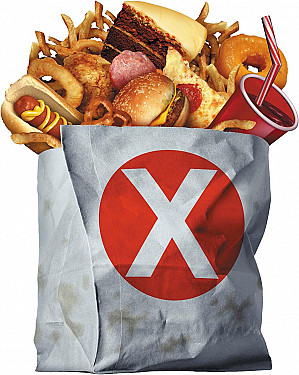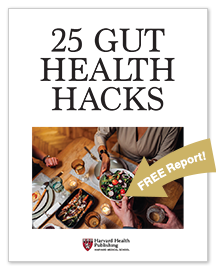Shake the salt habit
Cutting back on sodium offers indisputable health benefits. Simple changes can help you get there.
- Reviewed by Toni Golen, MD, Editor in Chief, Harvard Women's Health Watch; Editorial Advisory Board Member, Harvard Health Publishing; Contributor
 It’s no secret that salt intake fuels high blood pressure, the top risk factor for heart attack and stroke. But even after years of warnings, most people still choose to ignore the threat until it affects them personally. And most people still just don’t know where sodium (the crucial component of salt) lurks in their foods and drinks.
It’s no secret that salt intake fuels high blood pressure, the top risk factor for heart attack and stroke. But even after years of warnings, most people still choose to ignore the threat until it affects them personally. And most people still just don’t know where sodium (the crucial component of salt) lurks in their foods and drinks.
While our bodies need some sodium to work properly, most of us consume too much, according to the CDC. The average American ingests more than 3,300 milligrams (mg) of sodium each day, far more than the American Heart Association’s recommendation of no more than 2,300 mg (roughly the amount in a teaspoon of salt) and ideal intake of no more than 1,500 mg daily.
We’re paying for that recklessness: nearly half of American adults have high blood pressure, and an estimated 41% of women develop high blood pressure after menopause — when our cardiovascular risks tend to “catch up” with men’s. A sweeping Harvard-led study in the journal Circulation showed that 40 million deaths around the world could be averted over 25 years — nearly three deaths every minute — if we all slashed our average sodium intake by 30%.
“For most people, this isn’t a priority until they get diagnosed with high blood pressure and their doctor says they should cut down on sodium,” says Eric Rimm, a professor of epidemiology and nutrition at the Harvard T.H. Chan School of Public Health.
“Of course, salt is now ubiquitous in the food supply,” he adds. “There’s a lot more sodium in what we eat than there was 50 years ago, and you can’t just look at food and know how much is in there by color or even taste.”
Sodium hideouts
Historically, salt was used as a food preservative during times when refrigeration wasn’t available. But over time, the seasoning was increasingly added to foods and drinks to enhance flavor, creating a vicious cycle that leaves us craving even more.
It’s easy to spot it in salty snacks such as chips and crackers. But sodium is hidden in an array of everyday items, such as
- cereal
- rice and pasta
- processed foods like canned soups, deli meats, and frozen meals, many of which contain up to 1,500 mg per serving
- condiments such as soy sauce, ketchup, and salad dressings.
Rimm says the biggest — and perhaps most surprising — offender is bread, meaning everything from pizza crust to artisanal loaves. “To rise, bread needs salt and yeast, but usually there’s much more salt in there than needs to be,” he says.
Another major culprit is jarred sauces. “Pasta sauce can have 450 mg per serving,” he says. “People tend not to realize they’re getting that much sodium from simple foods like breads and sauces.”
Success strategies
This illuminating context can point to reasonable but effective ways to scale back our sodium intake. Rimm suggests these approaches:
Read food labels closely. A Nutrition Facts panel is on every packaged item we buy. Ideally, choose items with 140 mg or less of sodium per serving. Look for terms such as “low sodium,” “no added salt,” or “sodium free.” But beware: “Even low-sodium soy sauce still contains 1,000 mg per serving,” Rimm says. “Try diluting it with water to lower the sodium content further.”
Rinse canned goods. Vegetables and beans often soak in briny fluid. Rinsing in cold water can substantially lower the sodium in these items without changing the taste. “A can of black beans, for example, can contain 420 mg of sodium per serving,” Rimm says. “Rinsing can help, or just buy a no-salt version.”
Cook at home more often. “Most restaurants don’t list sodium content on the menu, unfortunately, and that’s where people get a lot of hidden sodium,” Rimm says. “That’s the biggest advantage of home cooking — the food itself is much easier to monitor.”
Use other seasonings instead. Paprika, curry powder, and turmeric can add a kick to savory foods without salt. “That’s the solution — find other ways to flavor foods that don’t include salt,” he says.
While laying off the salt shaker is a smart idea, table salt accounts for only a fraction of the sodium most people ingest — about 10%, Rimm notes. But combining all of these tactics can alter your palate quite rapidly, dulling longstanding salt cravings.
“You can change your taste for salt if you lay off sodium for several weeks,” Rimm says. “You’ll eat the same foods later and think, 'Wow, they’re so salty.’”
Image: © Jamie Grill Photography/Getty Images
About the Author

Maureen Salamon, Executive Editor, Harvard Women's Health Watch
About the Reviewer

Toni Golen, MD, Editor in Chief, Harvard Women's Health Watch; Editorial Advisory Board Member, Harvard Health Publishing; Contributor
Disclaimer:
As a service to our readers, Harvard Health Publishing provides access to our library of archived content. Please note the date of last review or update on all articles.
No content on this site, regardless of date, should ever be used as a substitute for direct medical advice from your doctor or other qualified clinician.
















